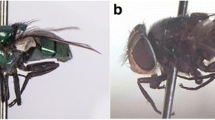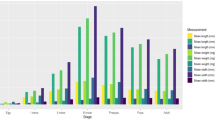Abstract
The determination of intrapuparial development periods and development times of insects with holometabolous metamorphosis is necessary both in terms of developmental biology and for minimum Post-mortem interval (PMImin) calculations in forensic entomology. In this study, Chrysomya albiceps (Wiedemann, 1819), which is a cosmopolitan species and one of the most rapidly attracted to carrion, was studied. The focus was the intrapuparial development periods of this species at varying temperatures (20, 25, and 30 °C), knowledge which is used in forensic entomology for the estimation of Post-mortem interval (PMI) and is a type of black box. At the specified temperatures, pupae were collected and puparia were dissected hourly; thus, developmental periods were determined, and minimum and maximum starting times of these periods were calculated. With this research, a total of 20 periods, nine of which are new, were determined. The hourly determination of intrapuparial development periods at three different temperatures is the first in the world for this species.

Similar content being viewed by others
Data availability
Available from the corresponding author on reasonable request.
References
Benecke M. A brief history of forensic entomology. Forensic Sci Int. 2001;120:2–14.
Matuszewski S, Bajerlein D, Konwerski S, Szpila K. Insect succession and carrion decomposition in selected forests of Central Europe. Part 2: composition and residency patterns of carrion fauna. Forensic Sci Int. 2010;195:42–51.
Matuszewski S, Bajerlein D, Konwerski S, Szpila K. Insect succession and carrion decomposition in selected forests of Central Europe. Part 1: pattern and rate of decomposition. Forensic Sci Int. 2010;194:85–93.
Matuszewski S, Bajerlein D, Konwerski S, Szpila K. An initial study of insect succession and carrion decomposition in various forest habitats of Central Europe. Forensic Sci Int. 2008;180:61–9.
Ozdemir S, Sert O. Determination of Coleoptera fauna on carcasses in Ankara province, Turkey. Forensic Sci Int. 2009;183:24–32.
Perez AE, Haskell NH, Wells JD. Evaluating the utility of hexapod species for calculating a confidence interval about a succession based postmortem interval estimate. Forensic Sci Int. 2014;241:91–5.
Fratczak-Lagiewska K, Grzywacz A, Matuszewski S. Development and validation of forensically useful growth models for Central European population of Creophilus maxillosus L. (Coleoptera: Staphylinidae). Int J Legal Med. 2020;134:1531–45.
Gruszka J, Matuszewski S. Estimation of physiological age at emergence based on traits of the forensically useful adult carrion beetle Necrodes littoralis L. (Silphidae). Forensic Sci Int. 2020;314:110407.
Voris R. The immature stages of the genera Ontholestes, Creophilus and Staphylinus Staphylinidae (Coleoptera). Ann Entomol Soc Am. 1939;32:288–303.
Mandeville JD. Rearing Phaenicia sericata (Diptera: Calliphoridae) on dry cat food with CSMA. J Med Entomol. 1988;25:197–8.
Haskell NH. Procedures in the entomology laboratory. In: Catts EP, Haskell NH, editors. Entomology and death: a procedural guide. Clemson, United States of America: Joyce’s Print Shop Inc.; 1990. p. 111–23.
Tantawi TI, Greenberg B. The effect of killing and preservative solutions on estimates of maggot age in forensic cases. J Forensic Sci. 1993;38:702–7.
Carvalho LML, Thyssen PJ, Linhares AX, Palhares FAB. A checklist of arthropods associated with pig carrion and human corpses in southeastern Brazil. Mem I Oswaldo Cruz. 2000;95:135–8.
Greenberg B, Kunich JC, editors. Entomology and the law: flies as forensic indicators. Cambridge: Cambridge University Press; 2002.
Grassberger M, Reiter C. Effect of temperature on Lucilia sericata (Diptera: Calliphoridae) development with special reference to the isomegalen- and isomorphen-diagram. Forensic Sci Int. 2001;120:32–6.
Amendt J, Krettek R, Zehner R. Forensic entomology. Naturwissenschaften. 2004;91:51–65.
Anderson GS. Forensic entomology. In: James SH, Nordby JJ, editors. Forensic science: an introduction to scientific an investigative techniques. 2nd ed. Boca Raton, Florida: CRC Press; 2005. p. 135–64.
Byrd JH, Castner JL. Forensic entomology: the utility of arthropods in legal investigations. 2nd ed. Florida: CRC Press; 2010.
Goff ML. Early postmortem changes and stages of decomposition. In: Amendt J, Campobasso CP, Goff ML, editors. Current concepts in forensic entomology. London, United Kingdom: Springer; 2010. p. 1–24.
Gennard D. Forensic entomology: an introduction. 2nd ed. Chichester: Wiley-Blackwell; 2012.
Al-Shareef LAH, Al-Qurashi SID. Study of some biological aspects of the blowfly Chrysomya albiceps (Wiedemann 1819) (Diptera: Calliphoridae) in Jeddah, Saudi Arabia. Egypt J Forensic Sci. 2016;6:11–6.
Zehner R, Amendt J, Boehme P. Gene expression analysis as a tool for age estimation of blowfly pupae. Forensic Sci Int. 2009;2:292–3.
Greenberg B. Flies as forensic indicators. J Med Entomol. 1991;28:565–77.
Brown K. Utility of the Calliphora vicina (Diptera: Calliphoridae) pupal stage for providing temporal information for death investigations. Hampshire, United Kingdom: University of Portsmouth; 2012.
Zajac BK, Amendt J. Bestimmung des Alters forensisch relevanter Fliegenpuppen. Rechtsmedizin. 2012;22:456–65.
Pujol-Luz JR, Barros-Cordeiro KB. Intra-puparial development of the females of Chrysomya albiceps (Wiedemann) (Diptera, Calliphoridae). Rev Bras Entomol. 2012;56:269–72.
Davies K, Harvey ML. Internal morphological analysis for age estimation of blow fly pupae (Diptera: Calliphoridae) in postmortem interval estimation. J Forensic Sci. 2013;58:79–84.
Pasquerault T, Cervantes L, Dourel L, Vincent B, Gaudry E, Rocheteau C. Estimation de l’âge de la nymphe de Calliphora vicina, C vomitoria et Lucilia sericata par l’observation de caractères morphologiques externes (Diptera, Calliphoridae). Bulletin de la Société entomologique de France. 2013;118:527–37.
Sert O, Ergil C. A study of the pupal development of Calliphora vomitoria (L., 1758) (Calliphoridae: Diptera) at different temperatures. Turk J Zool. 2021;45:277–295.
Brown K, Thorne A, Harvey M. Calliphora vicina (Diptera: Calliphoridae) pupae: a timeline of external morphological development and a new age and PMI estimation tool. Int J Legal Med. 2015;129:835–50.
Ma T, Huang J, Wang JF. Study on the pupal morphogenesis of Chrysomya rufifacies (Macquart) (Diptera: Calliphoridae) for postmortem interval estimation. Forensic Sci Int. 2015;253:88–93.
Karabey T, Sert O. The analysis of pupal development period in Lucilia sericata (Diptera: Calliphoridae) forensically important insect. Int J Legal Med. 2018;132:1185–96.
Sert O, Orsel GM, Sabanoglu B, Ozdemir S. A study of the pupal developments of Sarcophaga argyrostoma (Robineau-Desvoidy, 1830). Forensic Sci Med Pathol. 2020;16:12–9.
Salazar-Souza M, Couri MS, Aguiar VM. Chronology of the intrapuparial development of the blowfly Chrysomya albiceps (Diptera: Calliphoridae): application in forensic entomology. J Med Entomol. 2018;55:825–32.
Ames C, Turner B, Daniel B. The use of mitochondrial cytochrome oxidase I gene (COI) to differentiate two UK blowfly species - Calliphora vicina and Calliphora vomitoria. Forensic Sci Int. 2006;164:179–82.
Boehme P, Spahn P, Amendt J, Zehner R. Differential gene expression during metamorphosis: a promising approach for age estimation of forensically important Calliphora vicina pupae (Diptera: Calliphoridae). Int J Legal Med. 2013;127:243–9.
Boehme P, Spahn P, Amendt J, Zehner R. The analysis of temporal gene expression to estimate the age of forensically important blow fly pupae: results from three blind studies. Int J Legal Med. 2014;128:565–73.
Zajac BK, Amendt J, Verhoff MA, Zehner R. Dating pupae of the blow fly Calliphora vicina Robineau-Desvoidy 1830 (Diptera: Calliphoridae) for post mortem interval-estimation: validation of molecular age markers. Genes (Basel). 2018;9
Richards CS, Simonsen TJ, Abel RL, Hall MJR, Schwyn DA, Wicklein M. Virtual forensic entomology: improving estimates of minimum post-mortem interval with 3D micro-computed tomography. Forensic Sci Int. 2012;220:251–64.
Martin-Vega D, Simonsen TJ, Hall MJR. Looking into the puparium: Micro-CT visualization of the internal morphological changes during metamorphosis of the blow fly, Calliphora vicina, with the first quantitative analysis of organ development in cyclorrhaphous dipterans. J Morphol. 2017;278:629–51.
Örsel GM. Research on larval and pupal development periods of forensically important species Sarcophaga argyrostoma (Robineau-Desvoidy, 1830) (Diptera: Sarcophagidae) at different temperatures. Ankara, Turkey: Hacettepe University; 2016.
Wells JD, Lamotte LR. Estimating the postmortem interval. In: Byrd JH, Castner JL, editors. Forensic entomology: the utility of arthropods in legal investigations. 2nd ed. Boca Raton, Florida: CRC Press; 2010. p. 367–88.
Zumpt F. Myiasis in man and animals in the old world. London: Butterworths; 1965.
Grassberger M, Friedrich E, Reiter C. The blowfly Chrysomya albiceps (Wiedemann) (Diptera: Calliphoridae) as a new forensic indicator in Central Europe. Int J Legal Med. 2003;117:75–81.
Guimarães JH, Prado AP, Linhares AX. Tree newly introduced blowfly species in southern Brazil (Diptera, Calliphoridae). Rev Bras Entomol. 1978;22:53–60.
Kosmann C, Macedo MP, Barbosa TAF, Pujol-Luz JR. Chrysomya albiceps (Wiedemann) and Hemilucilia segmentaria (Fabricius) (Diptera, Calliphoridae) used to estimate the postmortem interval in a forensic case in Minas Gerais. Brazil Rev Bras Entomol. 2011;55:621–3.
Leal JLF, Oliveira TC, Carneiro SCAS, Santos ABR, Vasconcelos BCE. Estimativa do intervalo pós-morte em cadáveres congelados através da entomologia. Revista de cirurgia e traumatologia buco-maxilo-facial. 2013;13:41–8.
Klekovska D, Slavevska-Stamenković V, Smiljkov S, Hinić J, Rebok K, Janeska B. Forensic use of Chrysomya albiceps (Wiedemann, 1819): the first cases indicating postmortem interval for human corpses in Republic of Macedonia. J Entomol Zool Stud. 2017;5:320–3.
Ramos-Pastrana Y, Wolff M. Postmortem interval estimation based on Chrysomya albiceps (Diptera, Calliphoridae) in a forensic case in the Andean Amazon, Caquetá, Colombia. Acta Amazon. 2017;47:369–74.
Ireland S, Turner B. The effects of larval crowding and food type on the size and development of the blowfly, Calliphora vomitoria. Forensic Sci Int. 2006;159:175–81.
Sabanoglu B, Sert O. Determination of Calliphoridae (Diptera) fauna and seasonal distribution on carrion in Ankara Province. J Forensic Sci. 2010;55:1003–7.
Marchenko MI. Characteristic of development of the fly Chrysomya albiceps (Wd.) (Diptera, Calliphoridae). Entomologicheskoe Obozrenie. 1985;64:79–84.
Marchenko MI. Medicolegal relevance of cadaver entomofauna for the determination of the time of death. Forensic Sci Int. 2001;120:89–109.
Greenberg B. Nocturnal oviposition behavior of blow flies (Diptera: Calliphoridae). J Med Entomol. 1990;27:807–10.
Sert O, Kabalak M, Dinar M, Topçular M, Serbest C. Ankara İli Merkezinde Bulunan Calliphoridae Türlerinin Gece Yumurtlama Davranışları Üzerine Çalışmalar. IV Ulusal Biyolojik Antropoloji Sempozyumu; 4–6 November; Ankara, Turkey 2010.
Acknowledgements
This study is based on the part of the MSc thesis of the second author. We would like to thank Hacettepe University Scientific Research Projects Coordination Unit for the 03-G-006 numbered project for their support in the establishment of the laboratory where the experiments were conducted and Dr. Senem Özdemir for her valuable contributions in various stages of the study.
Funding
No funding was received for conducting this study.
Author information
Authors and Affiliations
Contributions
Conceptualization: OS; Investigation: OS, CE; Writing – Original Draft: OS, CE; Writing – review and editing: OS; Resources: OS; Supervision: OS.
Corresponding author
Ethics declarations
Ethical approval
This article does not contain any studies with human participants or animals performed by any of the authors. “No animals except flies were used.”
Additional information
Publisher’s Note
Springer Nature remains neutral with regard to jurisdictional claims in published maps and institutional affiliations.
Supplementary Information
Below is the link to the electronic supplementary material.
Rights and permissions
About this article
Cite this article
Sert, O., Ergil, C. An examination of the intrapuparial development of Chrysomya albiceps (Wiedemann, 1819) (Calliphoridae: Diptera) at three different temperatures. Forensic Sci Med Pathol 17, 585–595 (2021). https://doi.org/10.1007/s12024-021-00411-y
Accepted:
Published:
Issue Date:
DOI: https://doi.org/10.1007/s12024-021-00411-y




